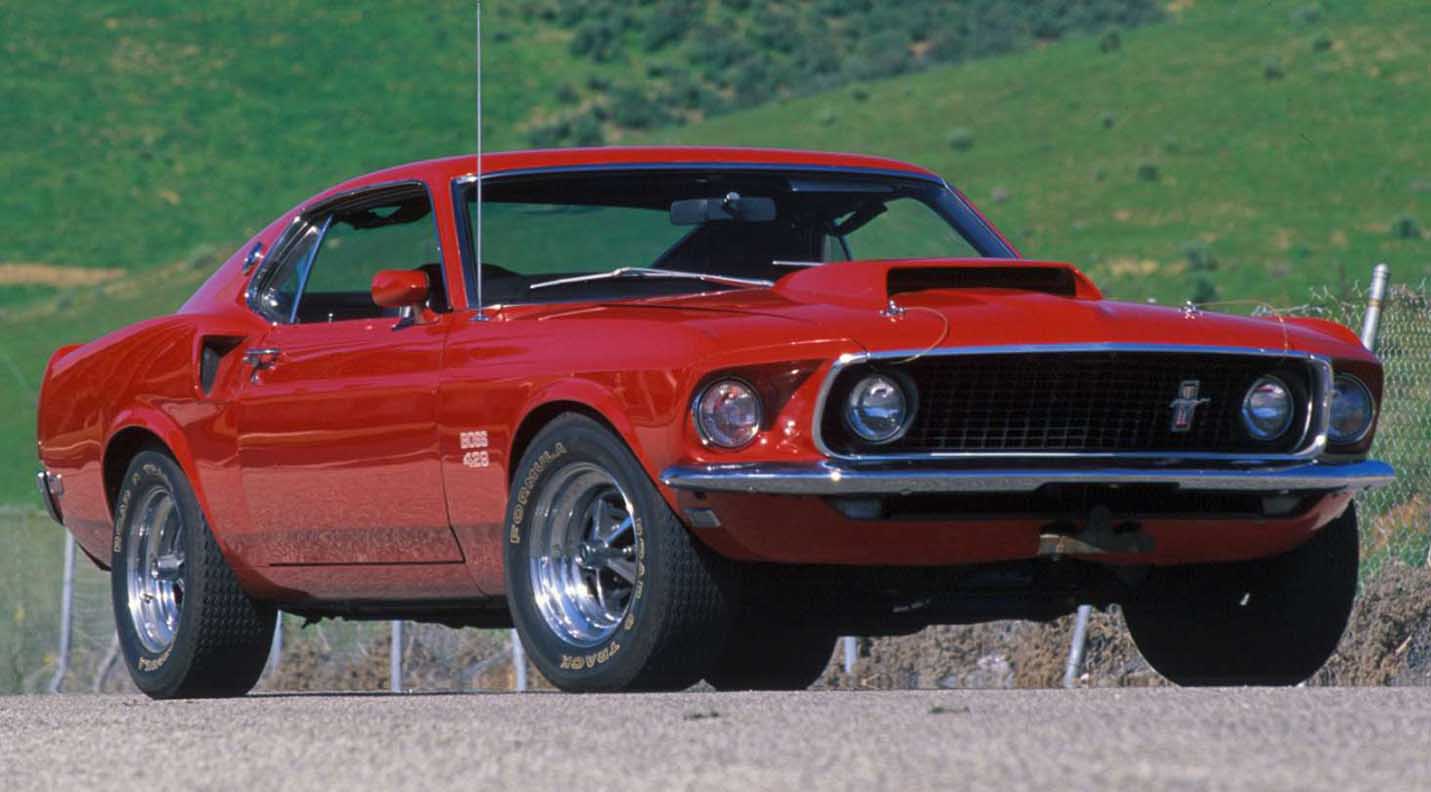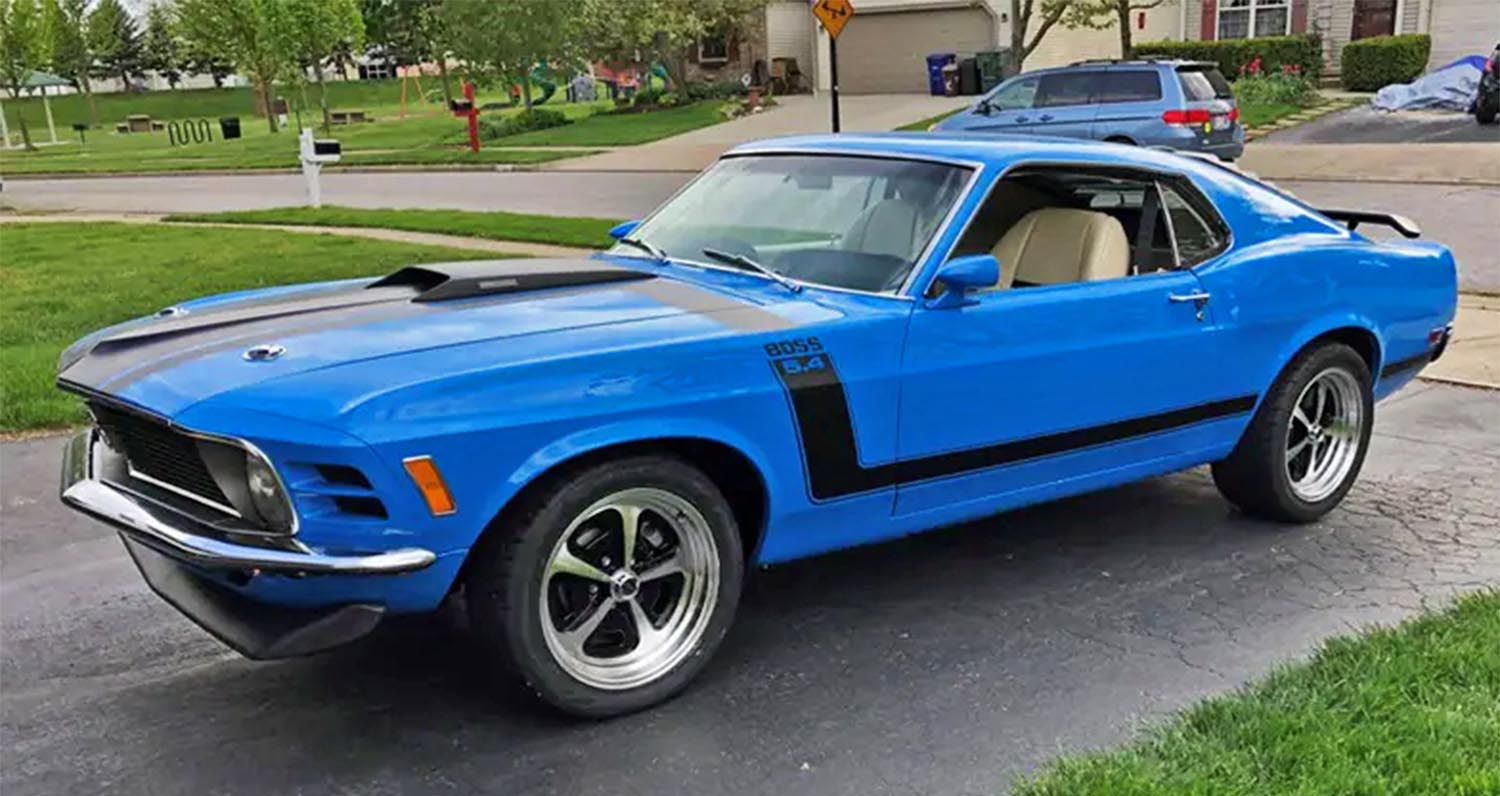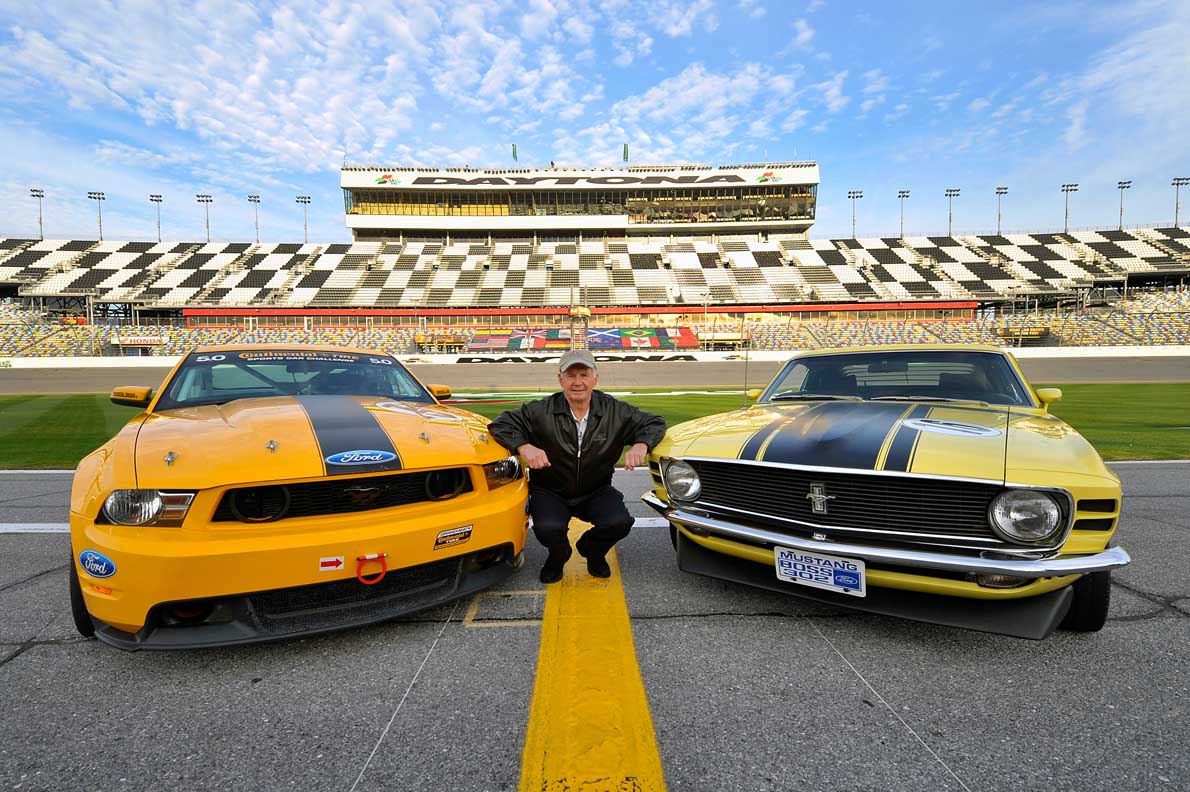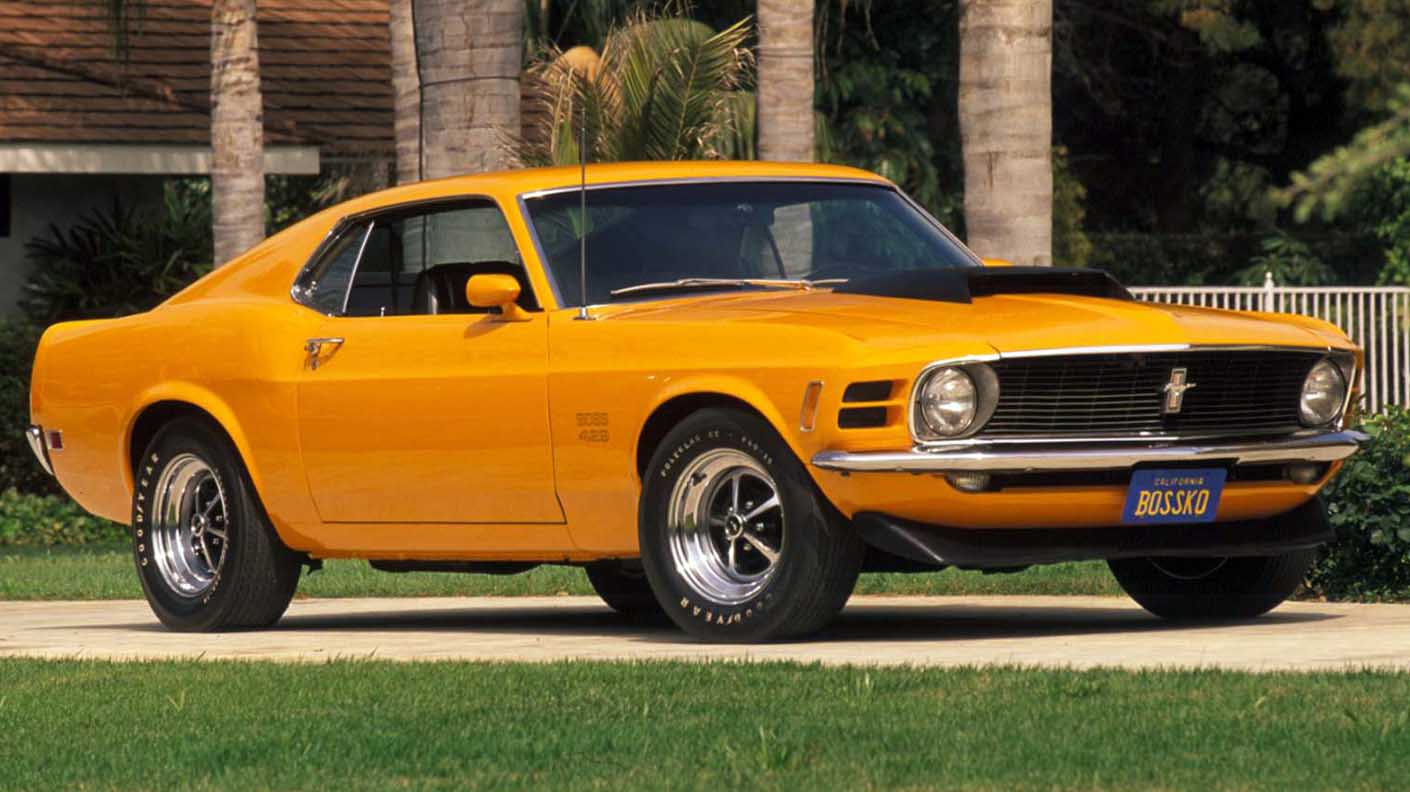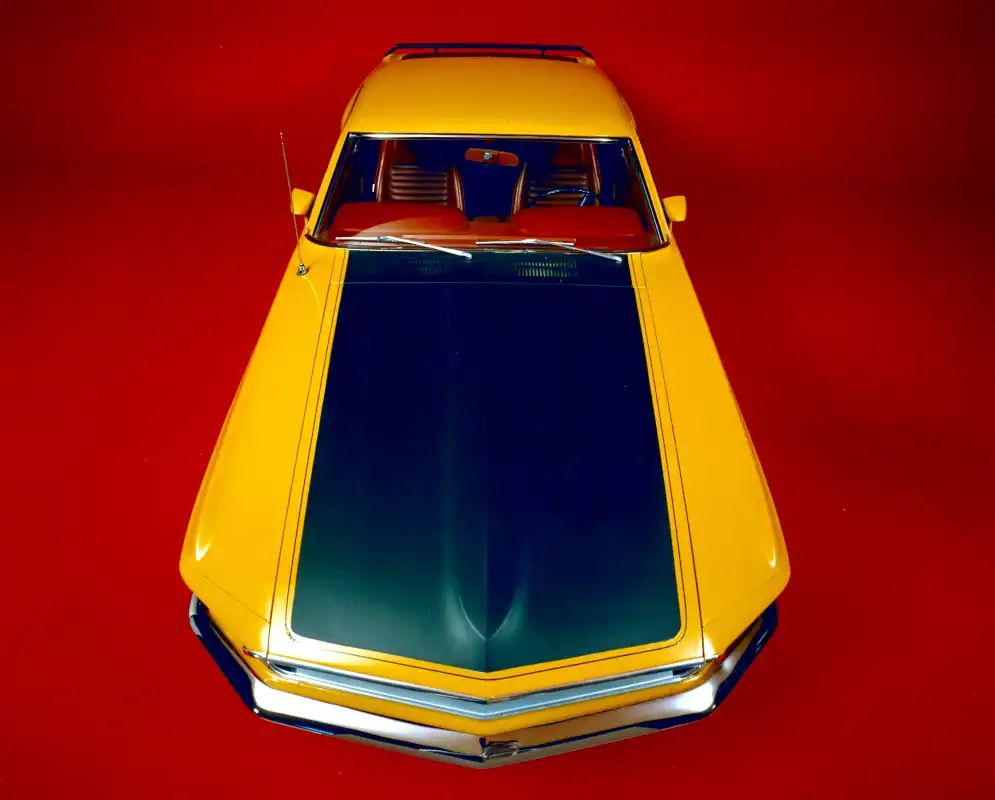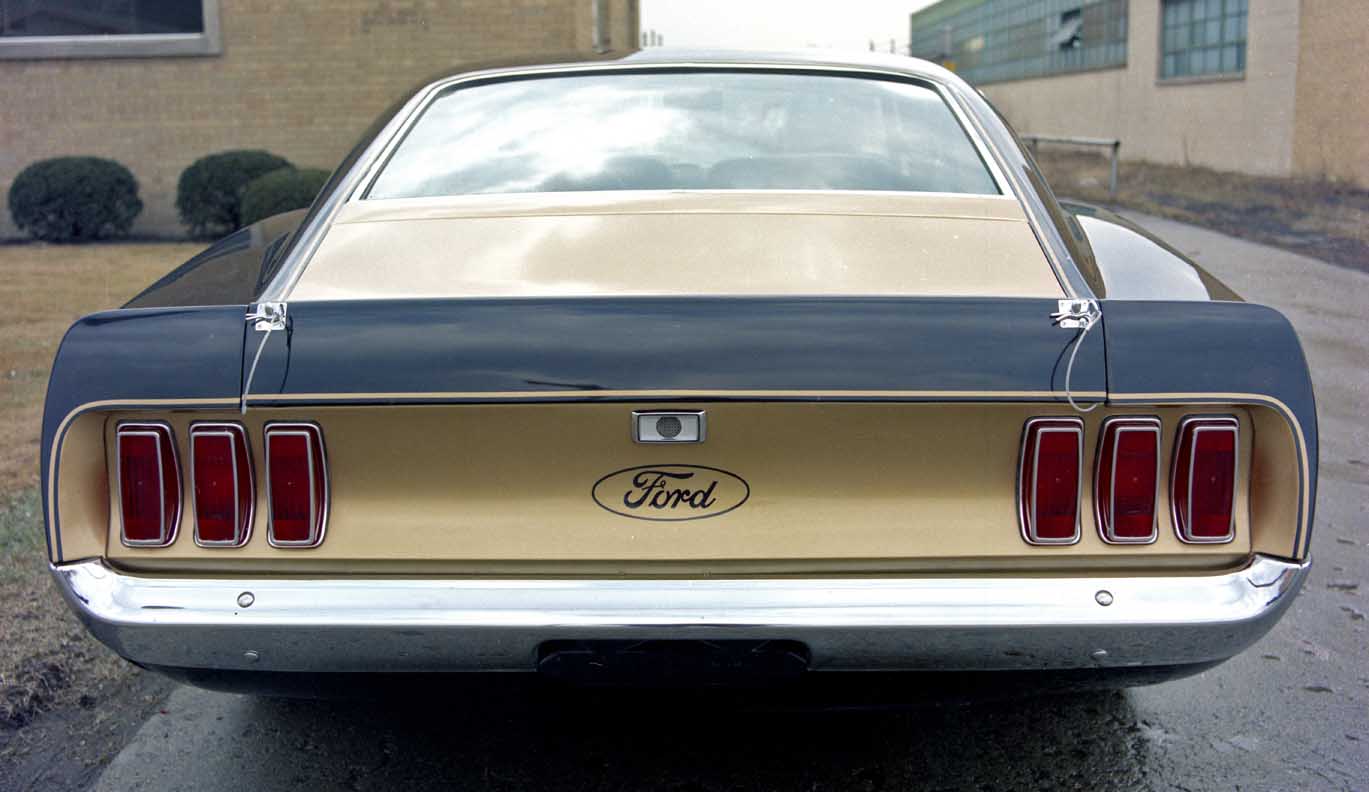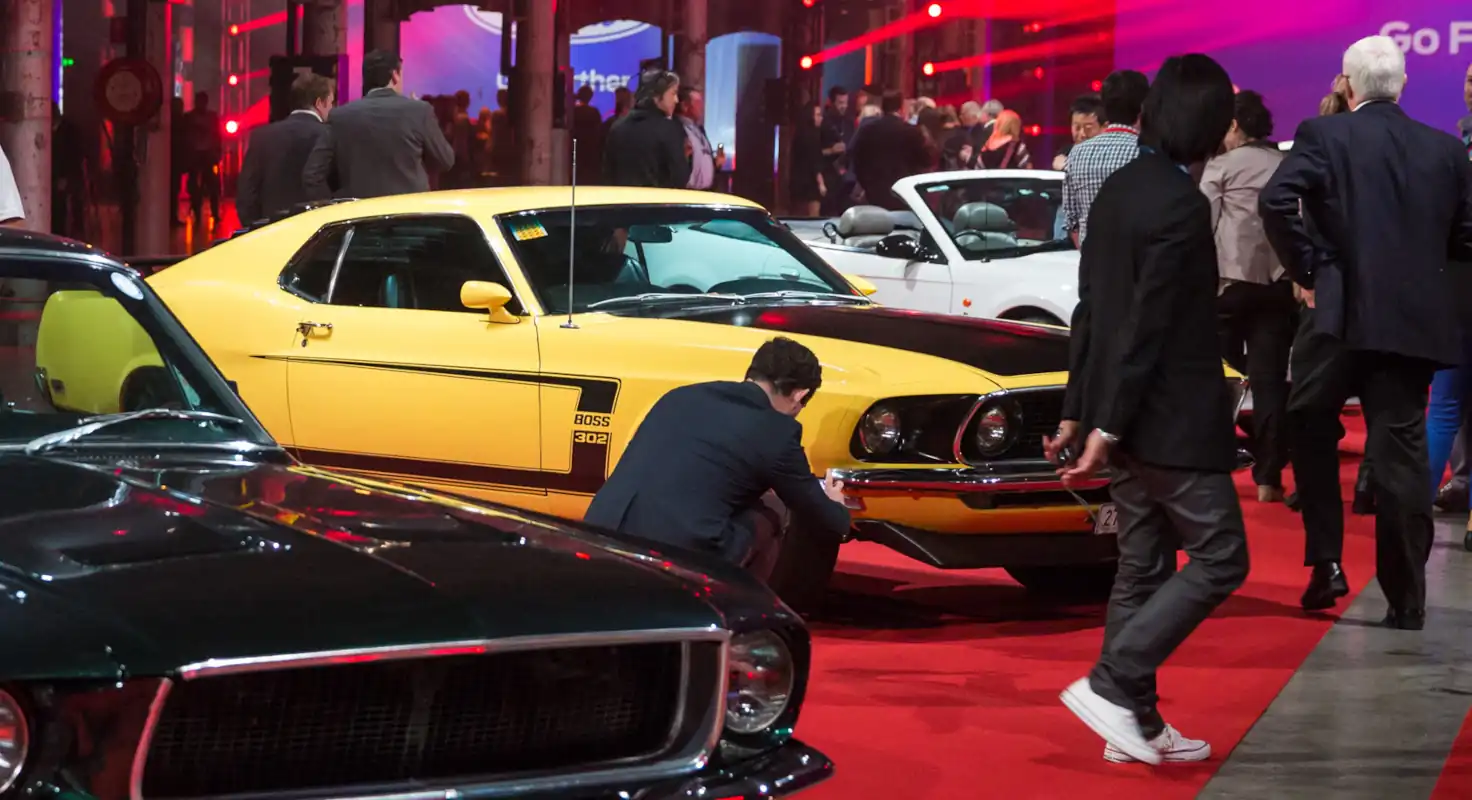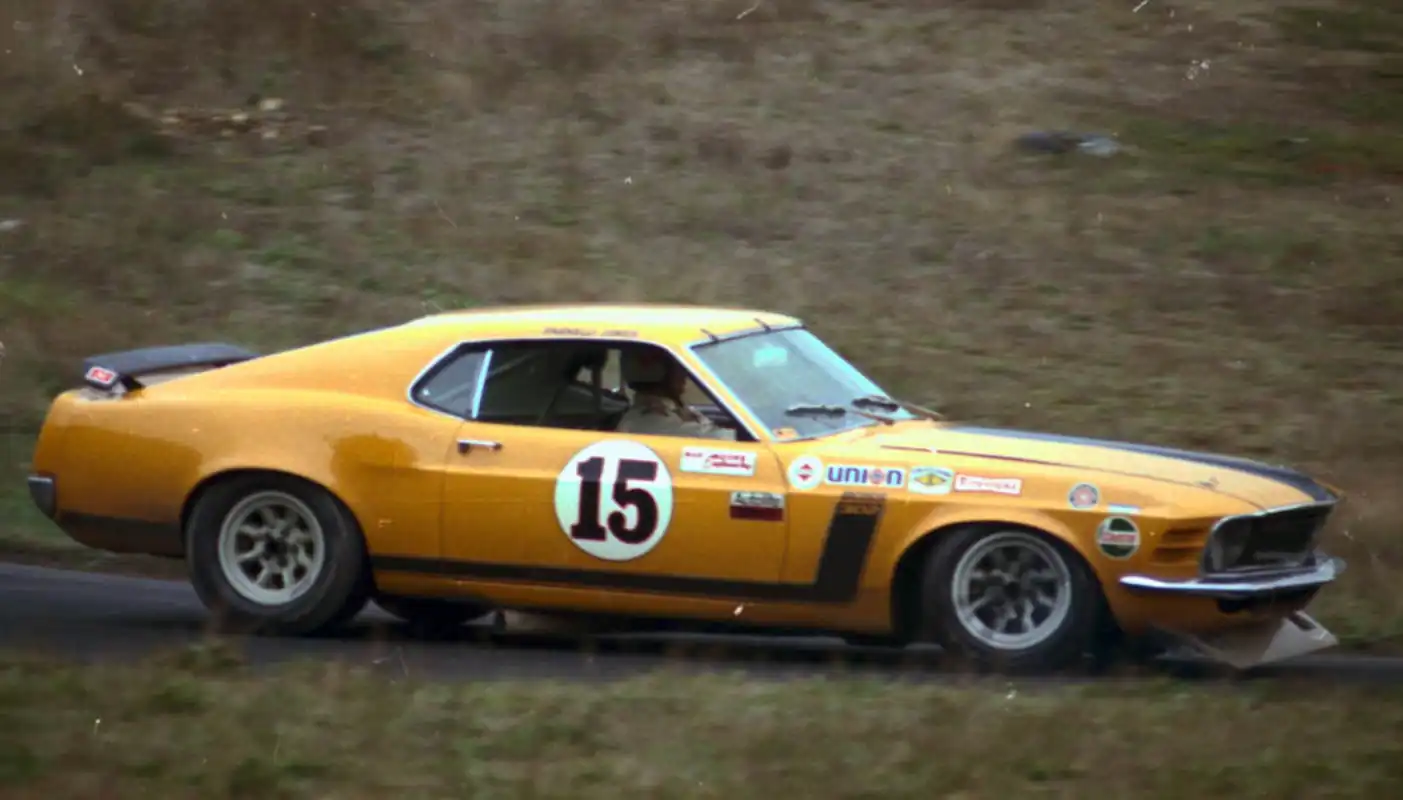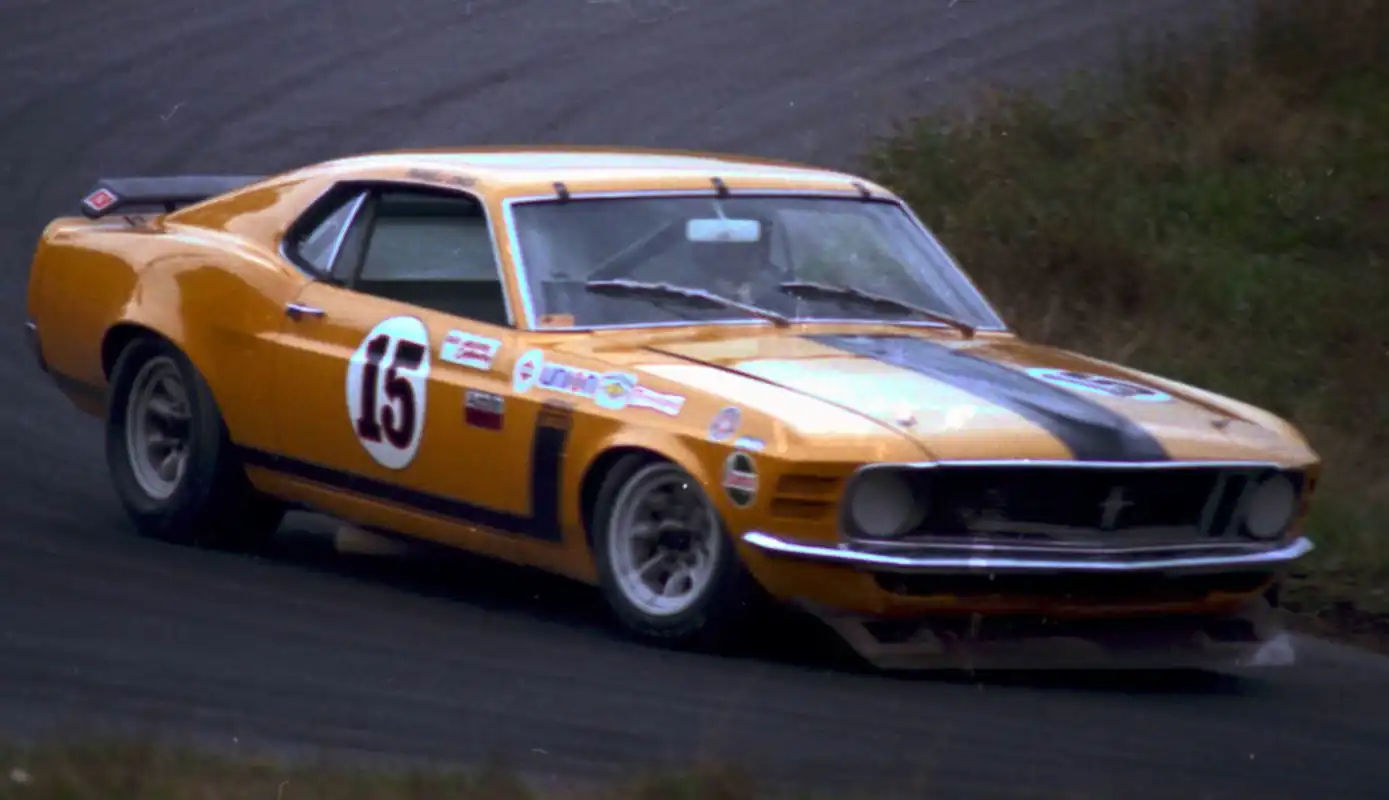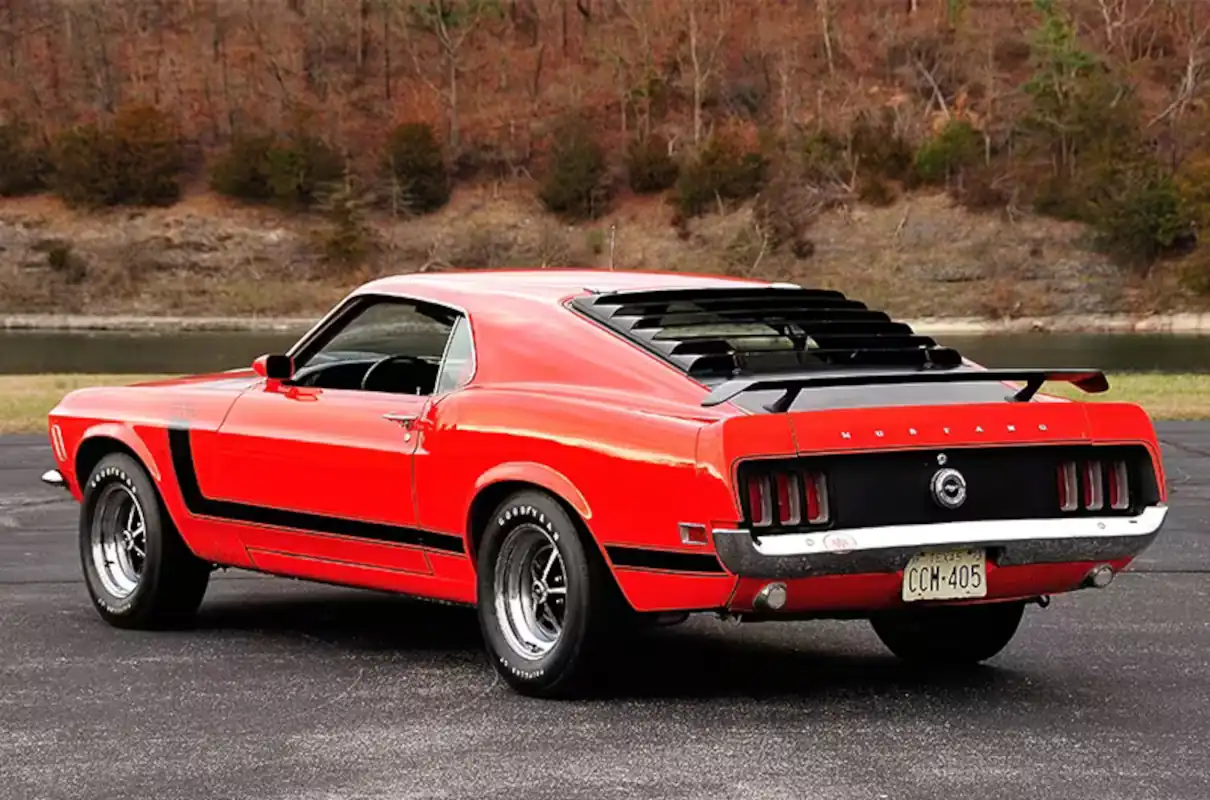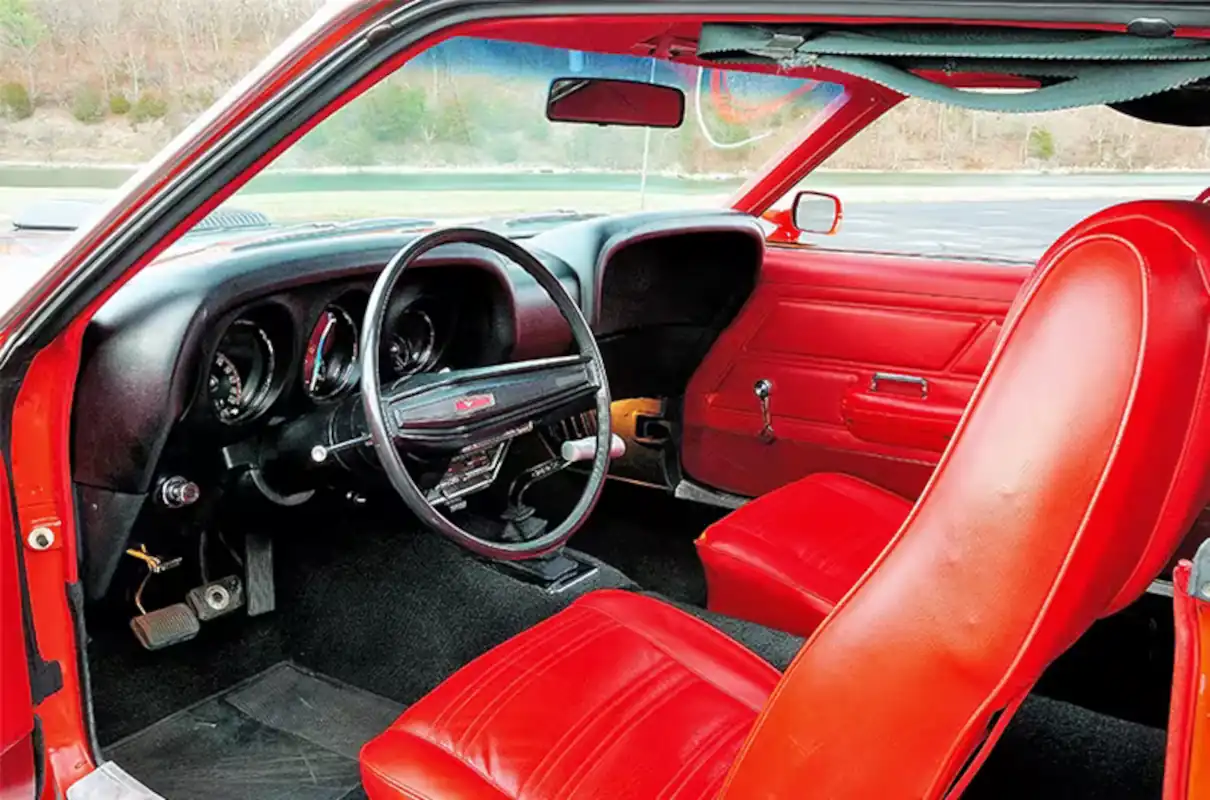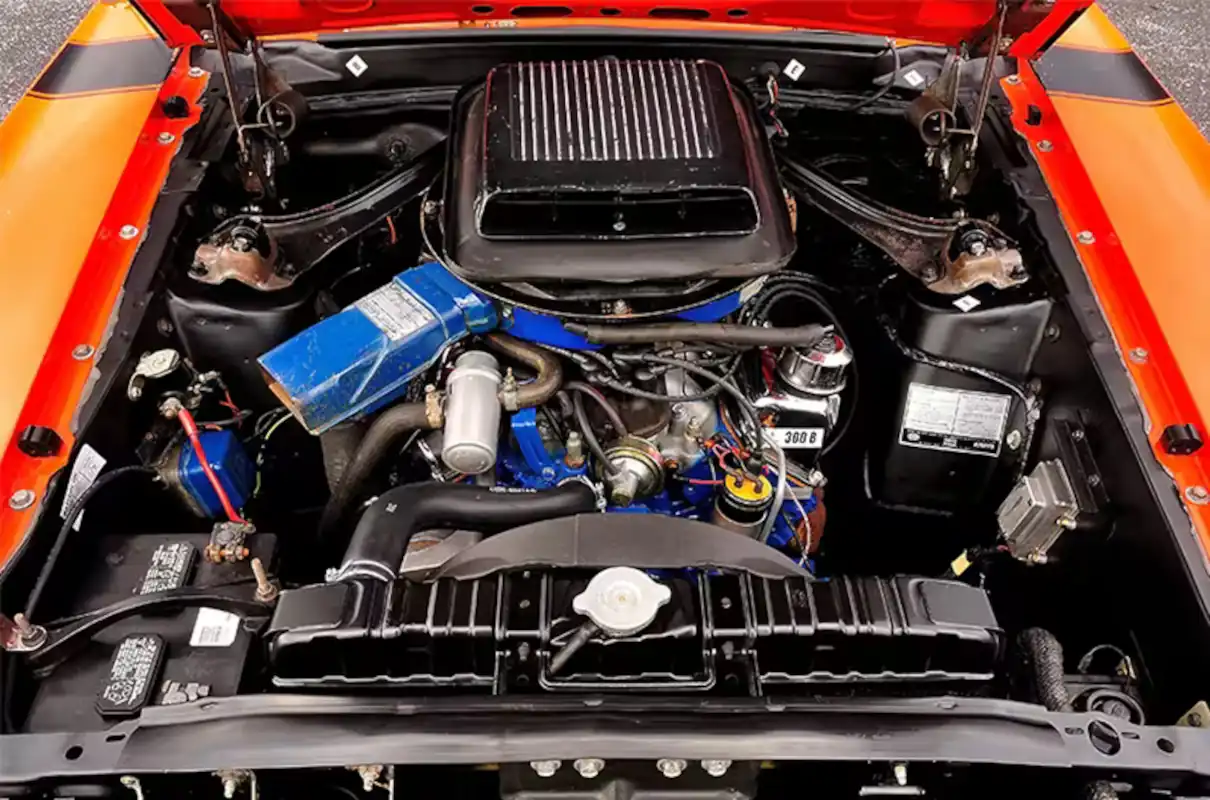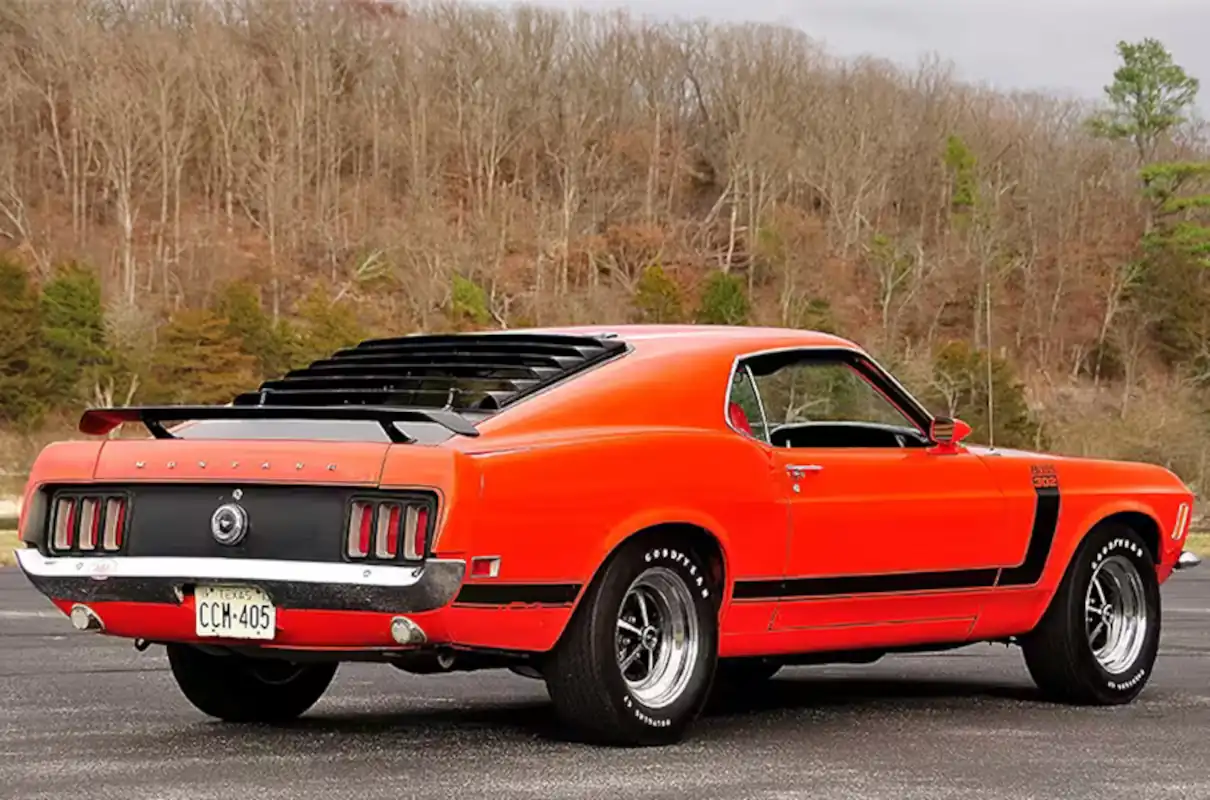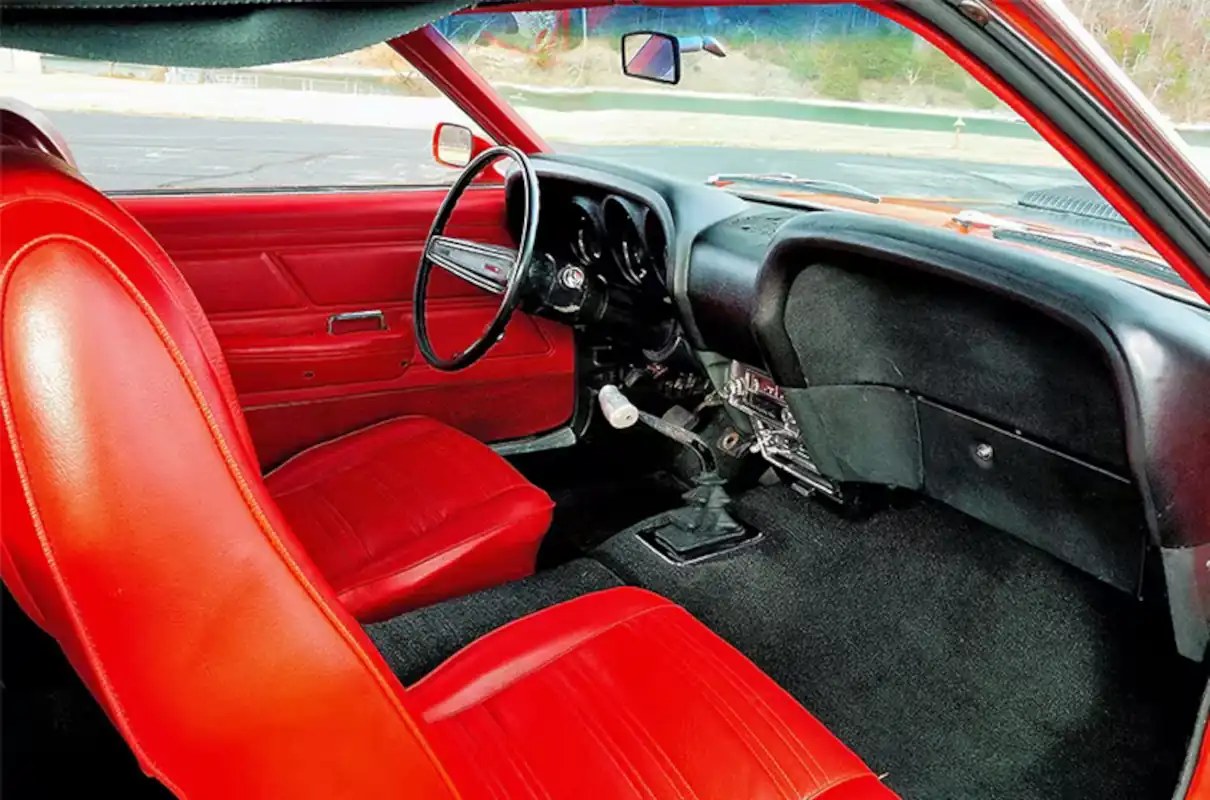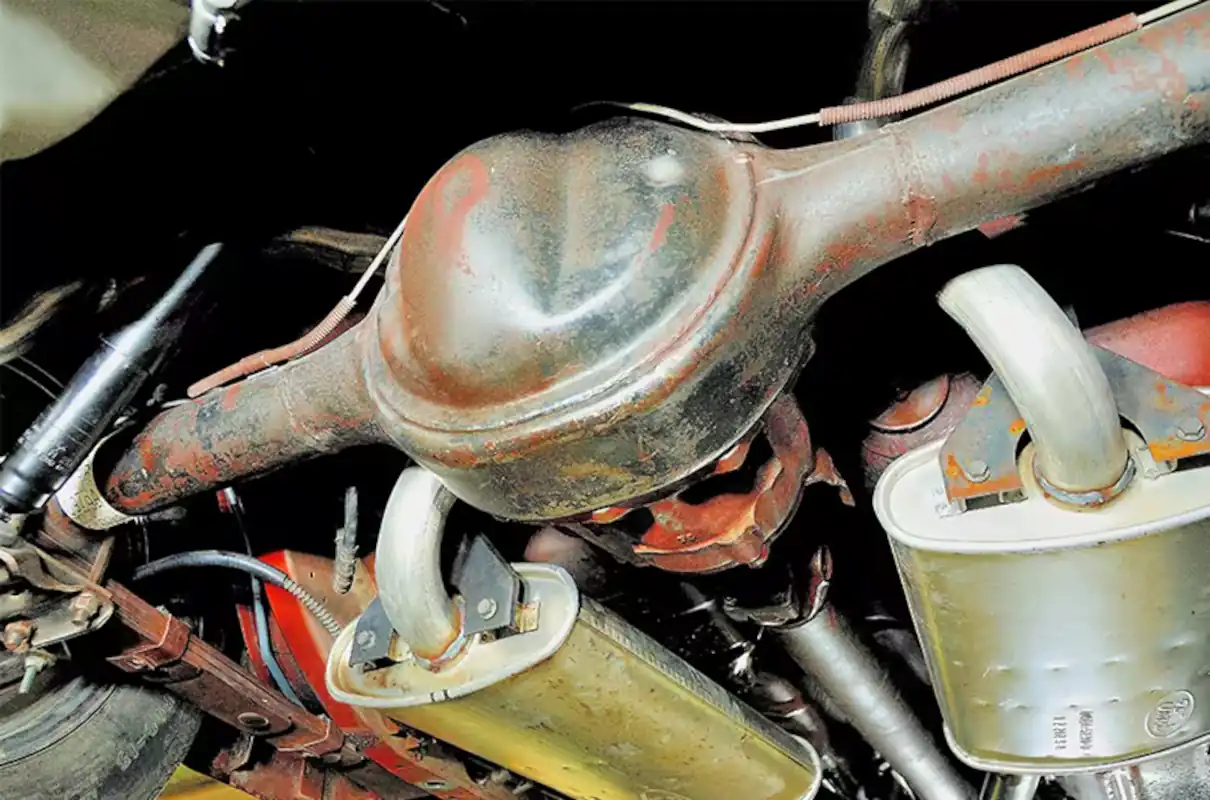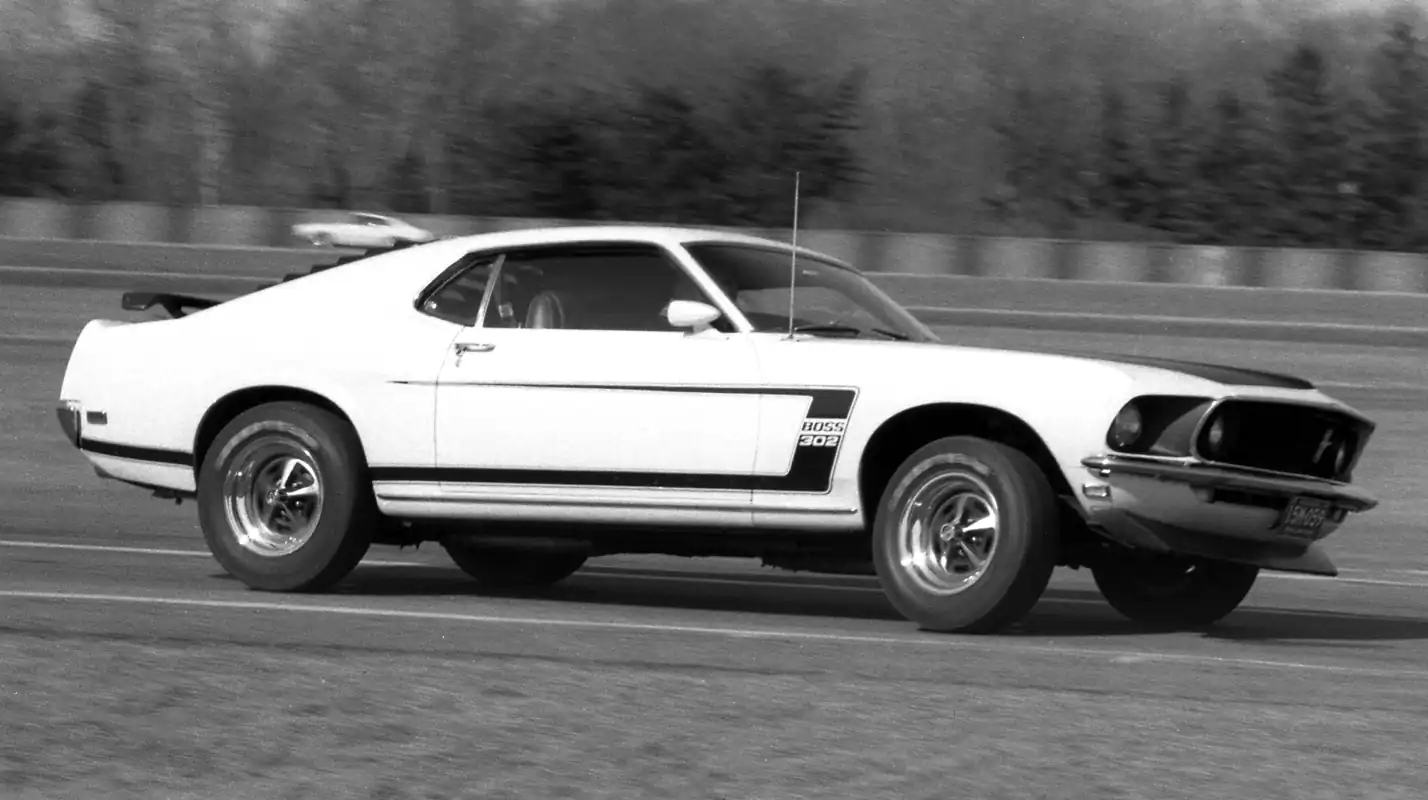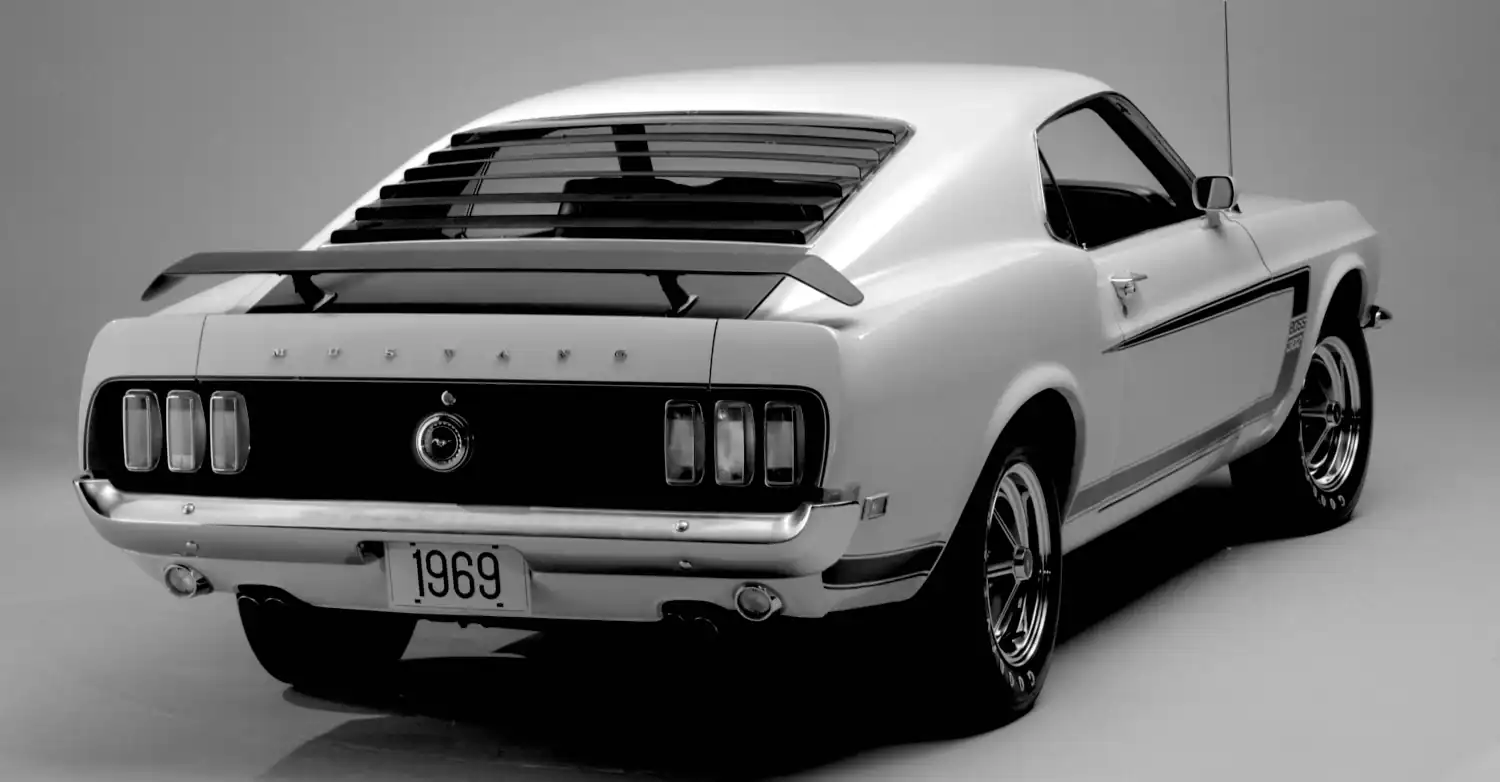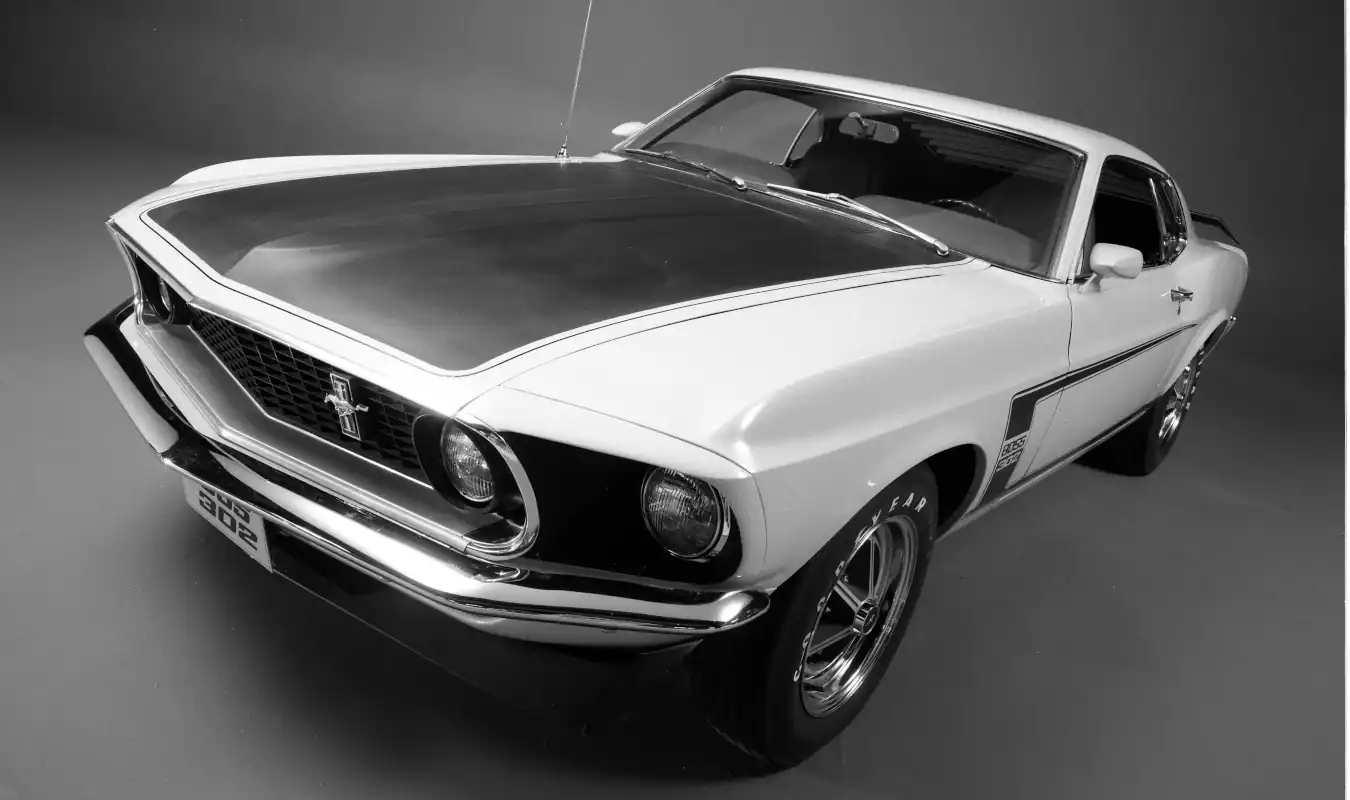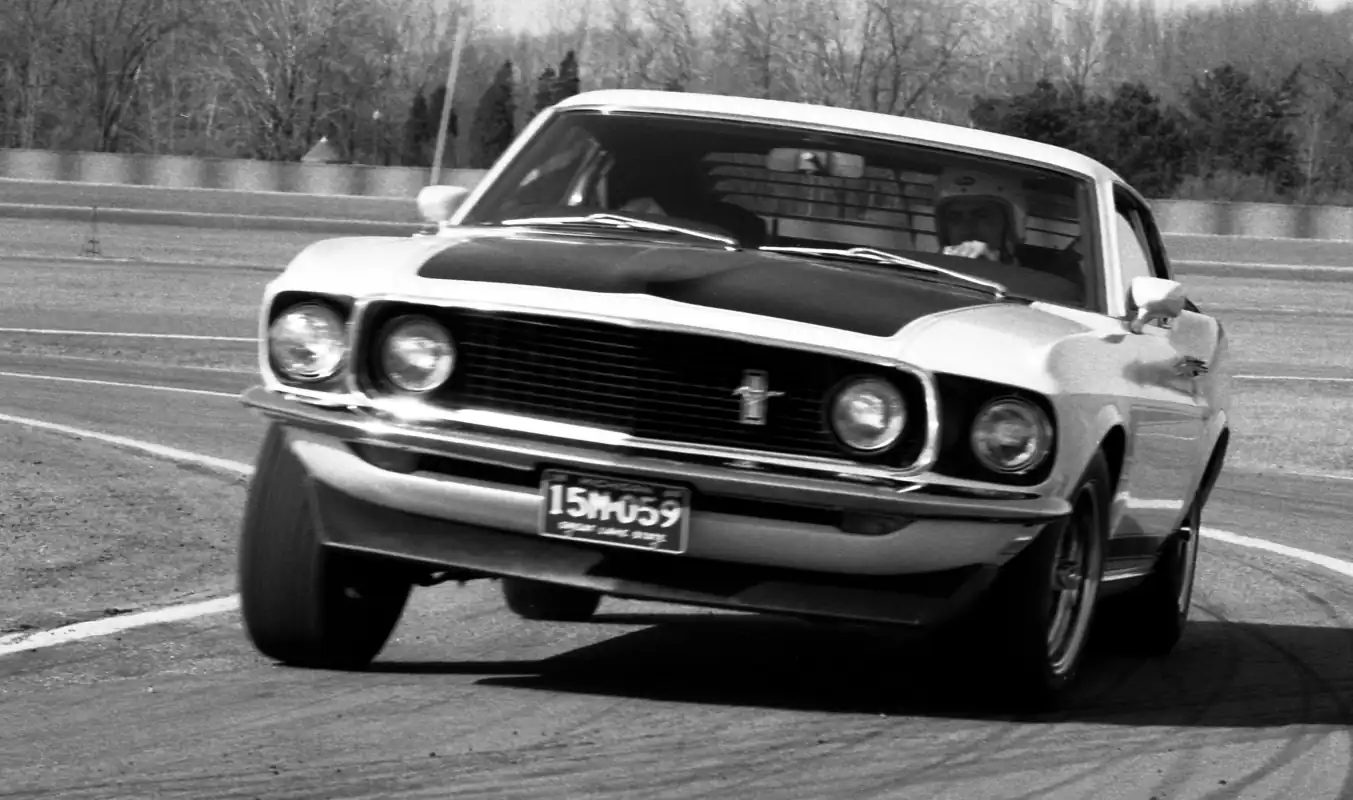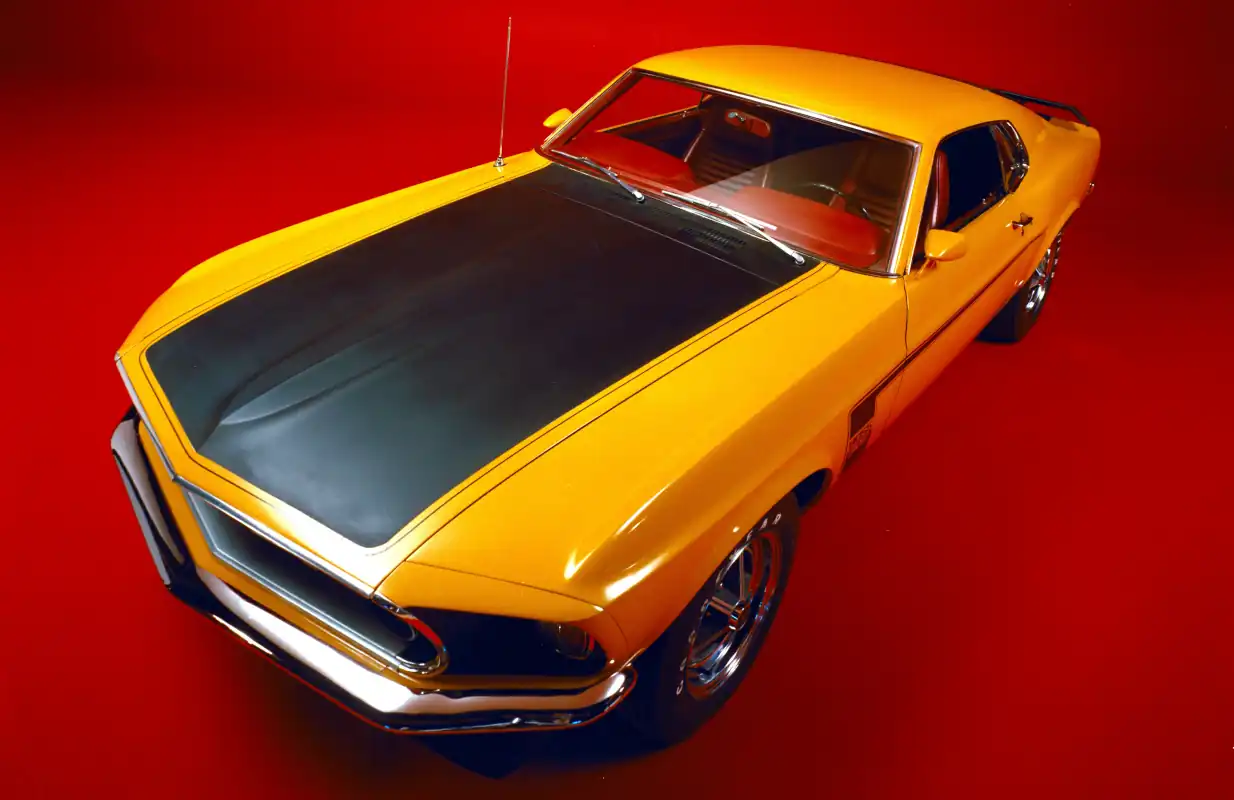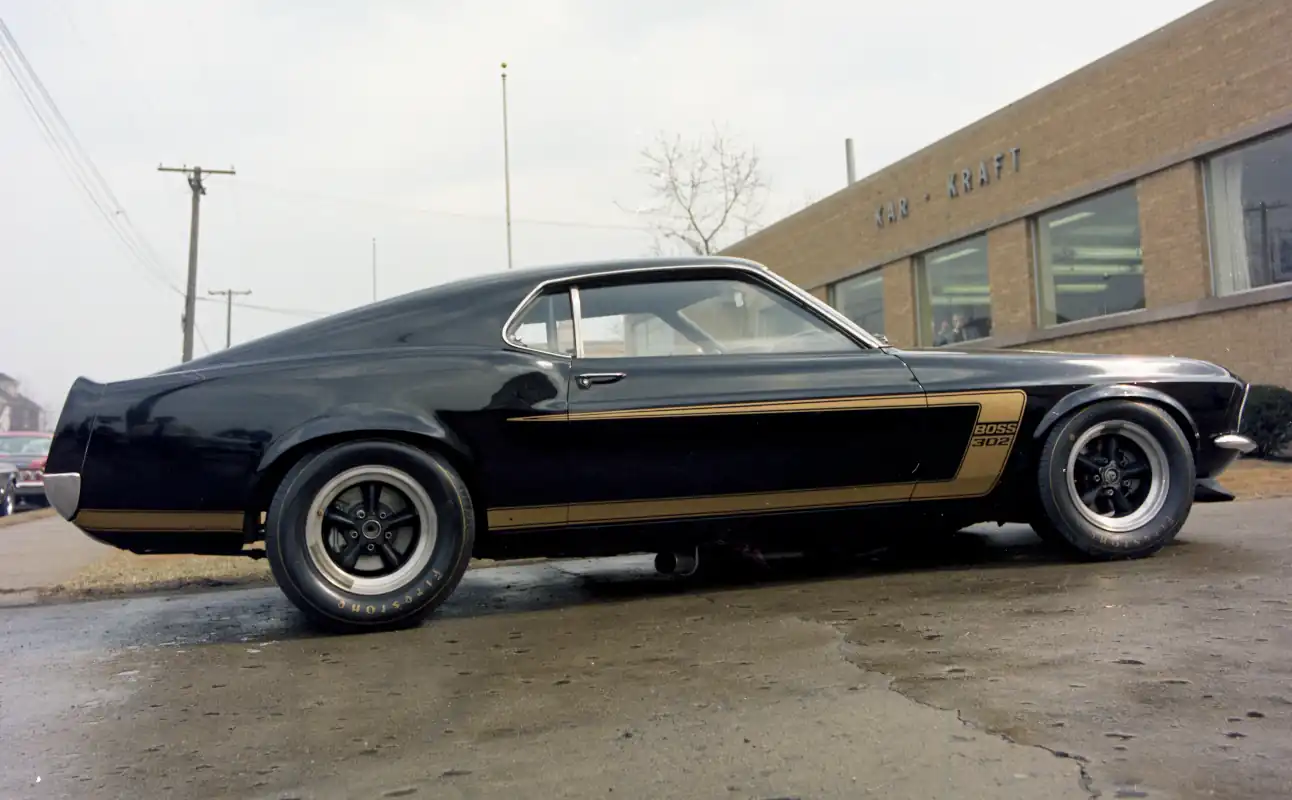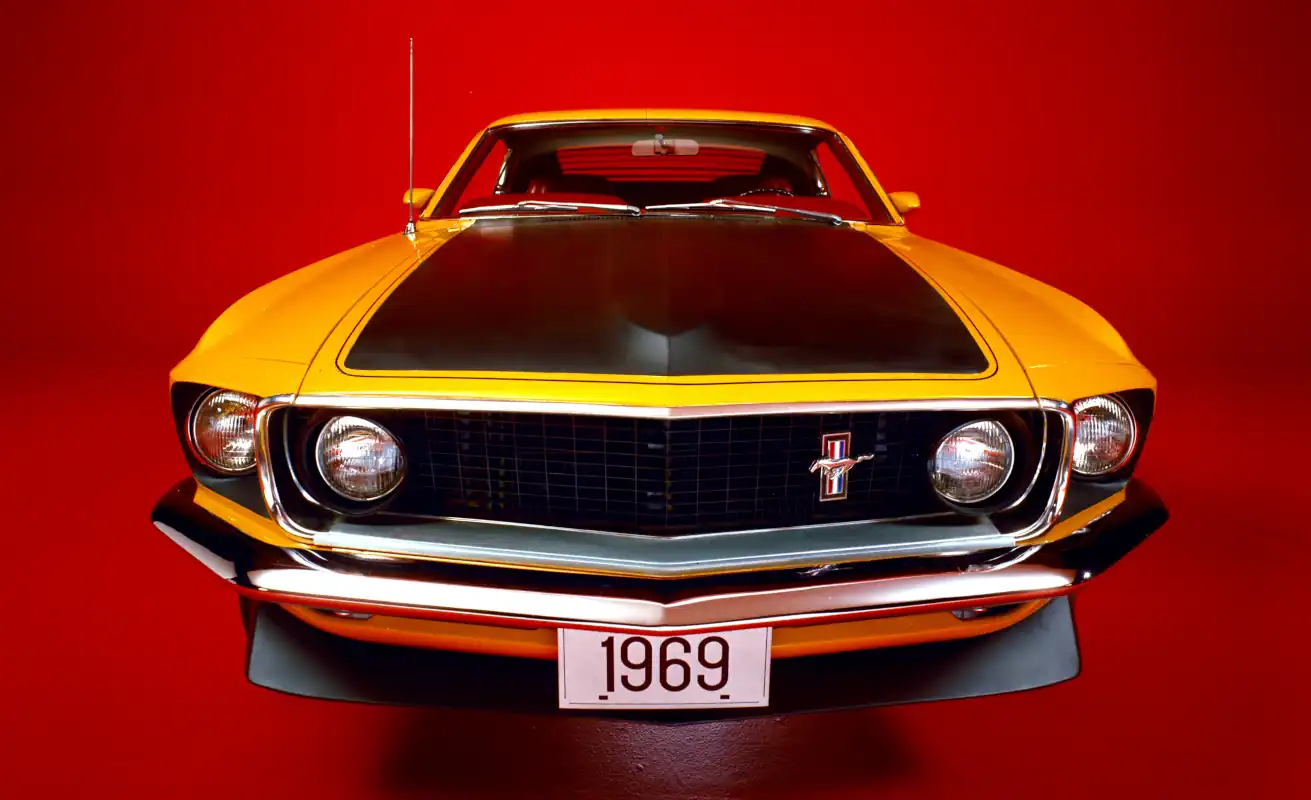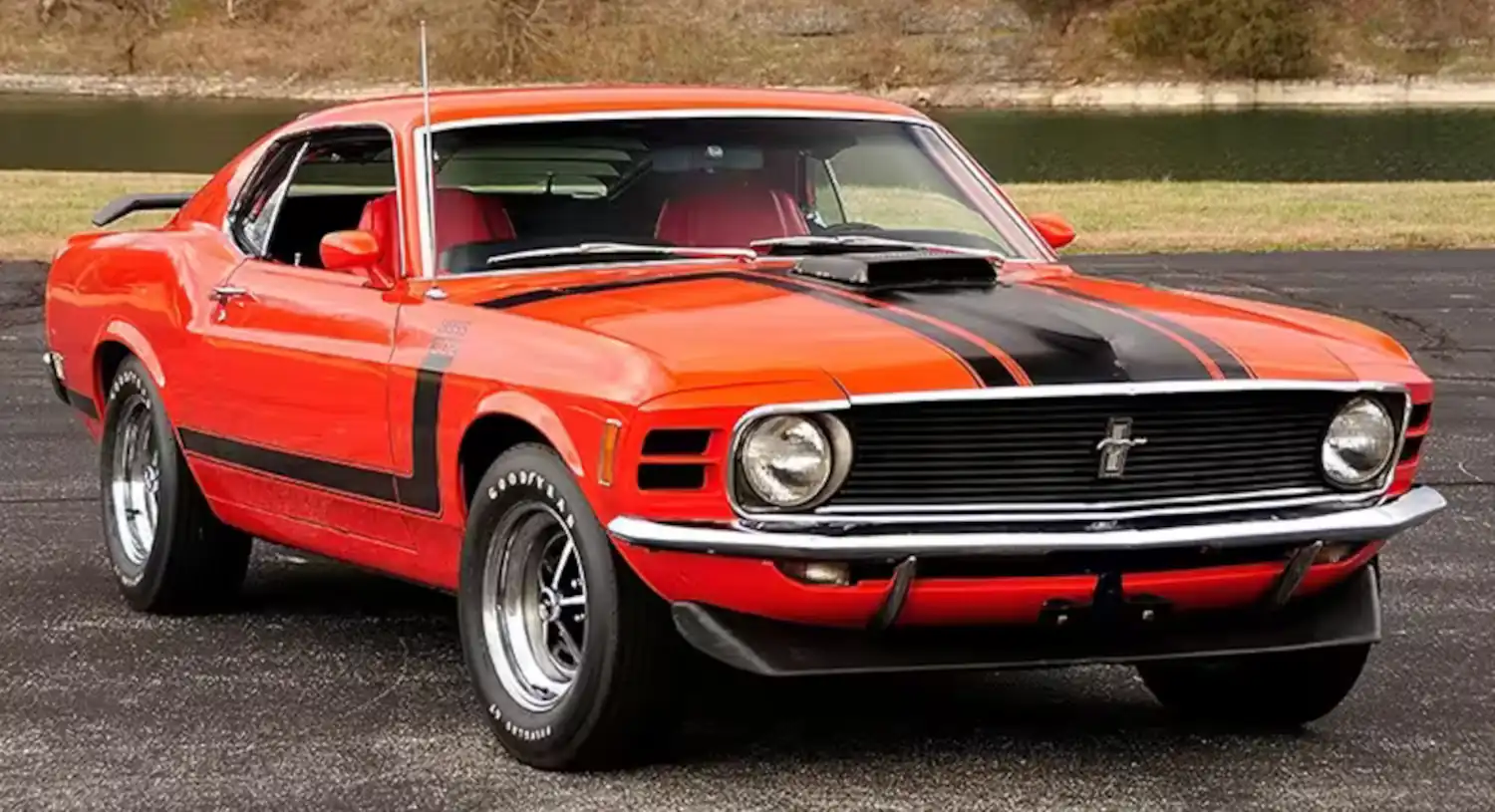
The Mustang Boss 302 is a high-performance variant of the Ford Mustang originally produced by Ford in 1969 and 1970, alongside its more powerful sibling the Boss 429 Mustang. Ford revived the name for another two year production run in 2012 and 2013. It was produced for the Trans Am racing series.
The Camaro/Mustang rivalry had begun in 1967 with the introduction of the Chevrolet Camaro by General Motors. The Camaro was the largest threat to the lead Ford had in the “pony car” field, a market segment largely created by Ford with the introduction of the Mustang in mid-year 1964. The performance of the Mustang with 289 and 390 engines was not up to the Camaro, with its small block and big block V8. In an effort to improve the Mustang’s image, Ford made a 428 Cobra Jet V8, and a Ford Boss 302 engine optional for the 1968 mid-year and 1969 models, respectively.
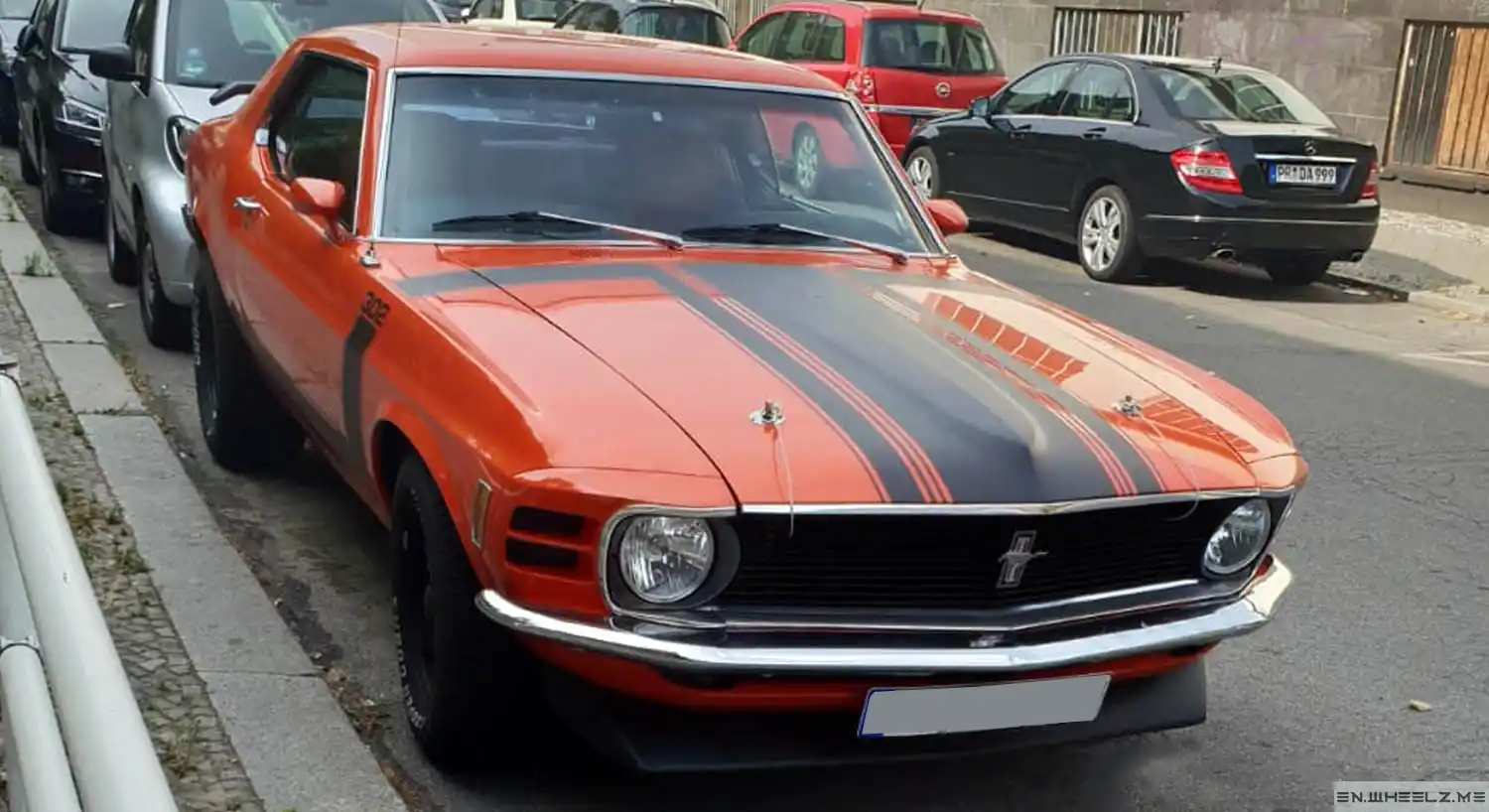
The 1969–70 Boss 302 (Hi-Po) engine was created in 1968 for the SCCA’s 1969 Trans-Am road racing series. Available in the Boss 302 Mustangs of 1969–70, it’s a unique Ford small-block engine featuring a thin-wall, high nickel content block casting. It differed substantially from regular 302s, with 4-bolt mains, screw in freeze plugs, and heads using a canted valve design being developed for the planned 351 Cleveland (which debuted the following year). The construction was aided by the two engines sharing a cylinder head bolt pattern, though the Boss 302 heads had to have their coolant passages slightly modified.
This optional engine, and indeed the entire vehicle package, including handling and aerodynamic aids, was made available for the express purpose of meeting the homologation guidelines to compete in the SCCA Trans-Am series, which limited engine displacement to 305 C.I.D. (5.0L) in order to compete. The Boss 429 Mustang was born in a similar way, except with the intent of homologating Ford’s new “semi-HEMI” 429 C.I.D. (7.0L) engine (to race in NASCAR, instead of Trans Am). The much larger engine in the Boss 429 reflects the less restrictive engine displacement limits of NASCAR at the time.
The Boss 302 Mustang was styled by Larry Shinoda, a former GM employee. The car featured a reflective “c-stripe”. The fake air scoops in the rear quarter panel fenders of the regular production 1969 Mustangs were eliminated on the Boss 302 models. A black horizontal rear window shade and a blackout hood were both options. It was one of the first production models with a front spoiler and rear deck wing. The name “Boss” came about when Shinoda was asked what project he was working on, he answered “the boss’s car” because the project was a secret. Also Shinoda had called it the “Boss” as an homage to the new President of Ford Semon “Bunkie” Knudson who had brought Shinoda over from GM’s Chevrolet Division after Knudson had left.
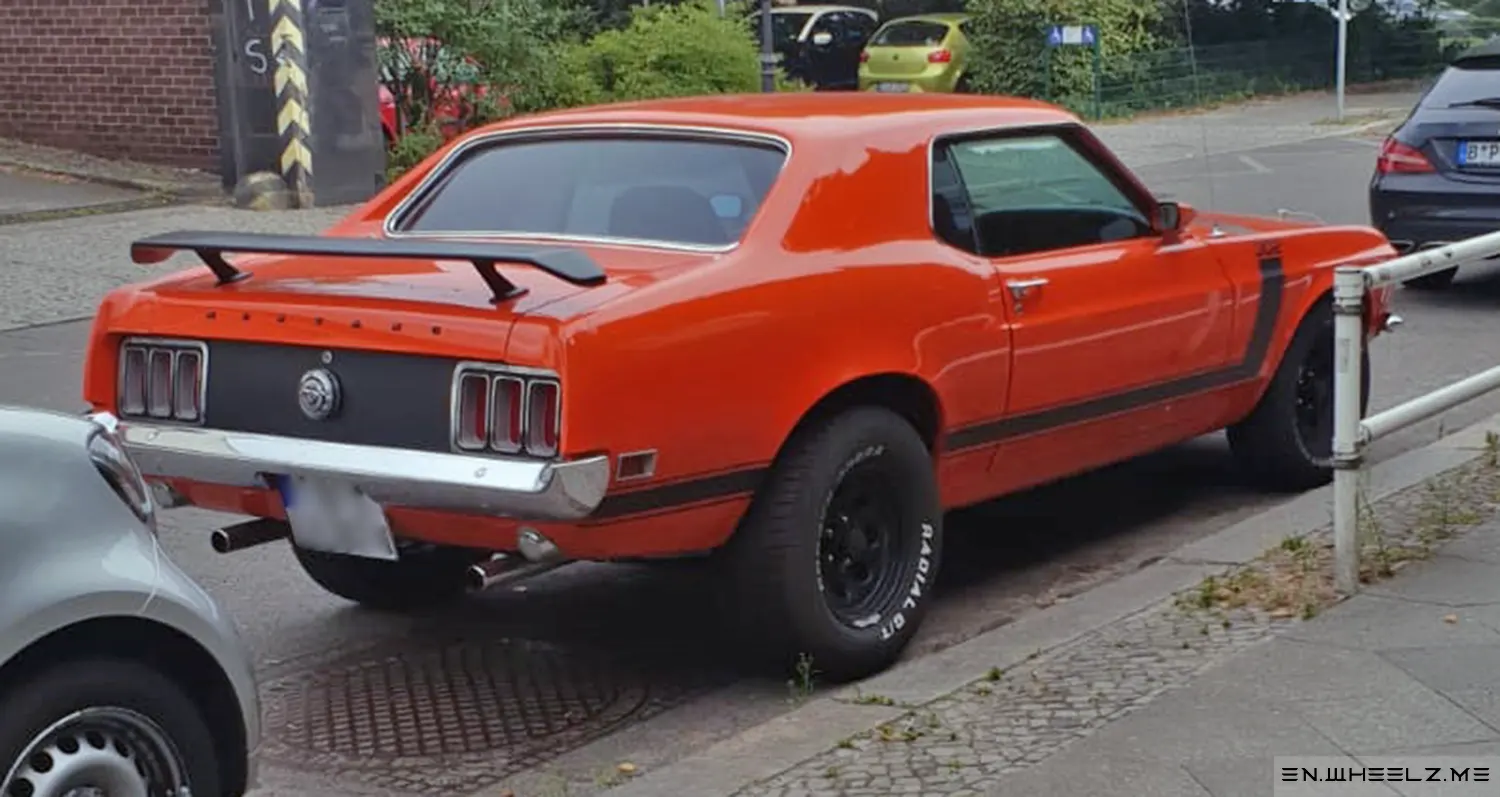
Changes for the 1970 model year included side “hockey stick” stripes which started along the top of the hood, along with the 1970 grille which replaced the four headlights with two vents in the outside position while retaining dual headlights within the grille opening. The dual exhaust system was redesigned, along with the competition suspension and a standard Hurst shifter. The intake valves were slightly smaller, and cast aluminum valve covers replaced the chrome. With a suggested price of $3,720, a total of 7,013 were sold.
In addition to a lower ride , standard equipment included front disc brakes, larger sway bars, heavier duty spindles, reinforced shock towers, a four speed manual transmission, and the solid-lifter Boss 302 V8 engine, with its free-breathing Cleveland style heads, which had valves larger than most engines more than a third larger in displacement. This “G Code” engine was rated at 290 hp (216 kW).
The 1970 model could accelerate from 0 to 60 mph (97 km/h) in 6.9 seconds, and the quarter mile (~400 m) took 14.6 seconds, reaching a speed of 98 mph (158 km/h).
Although Ford’s Drag Pack option with a special oil cooler was never formally offered on the Boss 302, it was often included with the 4.30:1 rear axle ratio. This coveted option is recognizable when the hood is opened to reveal Ford’s vertically mounted oil cooler in front of the radiator. Ford also had an option for Boss 302’s and 429’s for deluxe interior rather than standard interior
Trans-Am racing – 1969 Mustang Boss 302 race car
The SCCA Trans-Am series was popular in the late 1960s, especially after the birth of the “pony car”. A type of “stock-car” racing usually held on road courses, the series limited maximum engine displacement to 5 liters, or 305 cubic inches. In an effort to be competitive, various Detroit car manufacturers produced some a number of variants of their usual “pony car” lineups in both road and track trim (for homologation purposes), equipped with high-performing variants of their “small” 300-inch class V8 engines in order to make as much power as possible from the limited displacement. The Boss 302 program was part of an effort by the Ford Motor Company to win the coveted SCCA Trans-Am Championship in 1969 and 1970. Penske Camaros had triumphed in 1968 and 1969. Team Penske switched to AMC Javelin the following year so the Boss 302’s direct competition in the 1970 series were the AAR Cudas, the Pontiac Firebird, the Team Chaparral Camaros, and the Penske AMC Javelins.
The Ford entry for 1969 and 1970 was the Boss 302 Mustang. In 1969, two factors prevented victory; 1) Tire trouble. 2) Slow pit stops. With Roger Penske (a.k.a. “The organizer”) as Chevrolet’s racing team manager, the pit stops were magically choreographed and organized to perfection. When pit stop times between Mustangs and Camaros are compared, it turns out Ford lost several races “in the pits”. Ford was also using Firestone brand tires, which gave them trouble in 1969. In 1970 they switched to Goodyear. The factory effort was headed up by Bud Moore, who fielded two cars in the 1970 season, and won the championship that year. The Bud Moore Mustangs edged out Team Penske’s Javelins, and lead Penske driver Mark Donohue lost out to Bud Moore driver Parnelli Jones. Then, in 1971 AMC came out with a redesigned Javelin and returned to the track with ex-Mustang driver, George Follmer and Mark Donohue. With Mark Donohue behind the wheel of the AMC Javelin, the Mustang and the others were defeated in 1971, and again with George Follmer driving the Javelin in 1972.
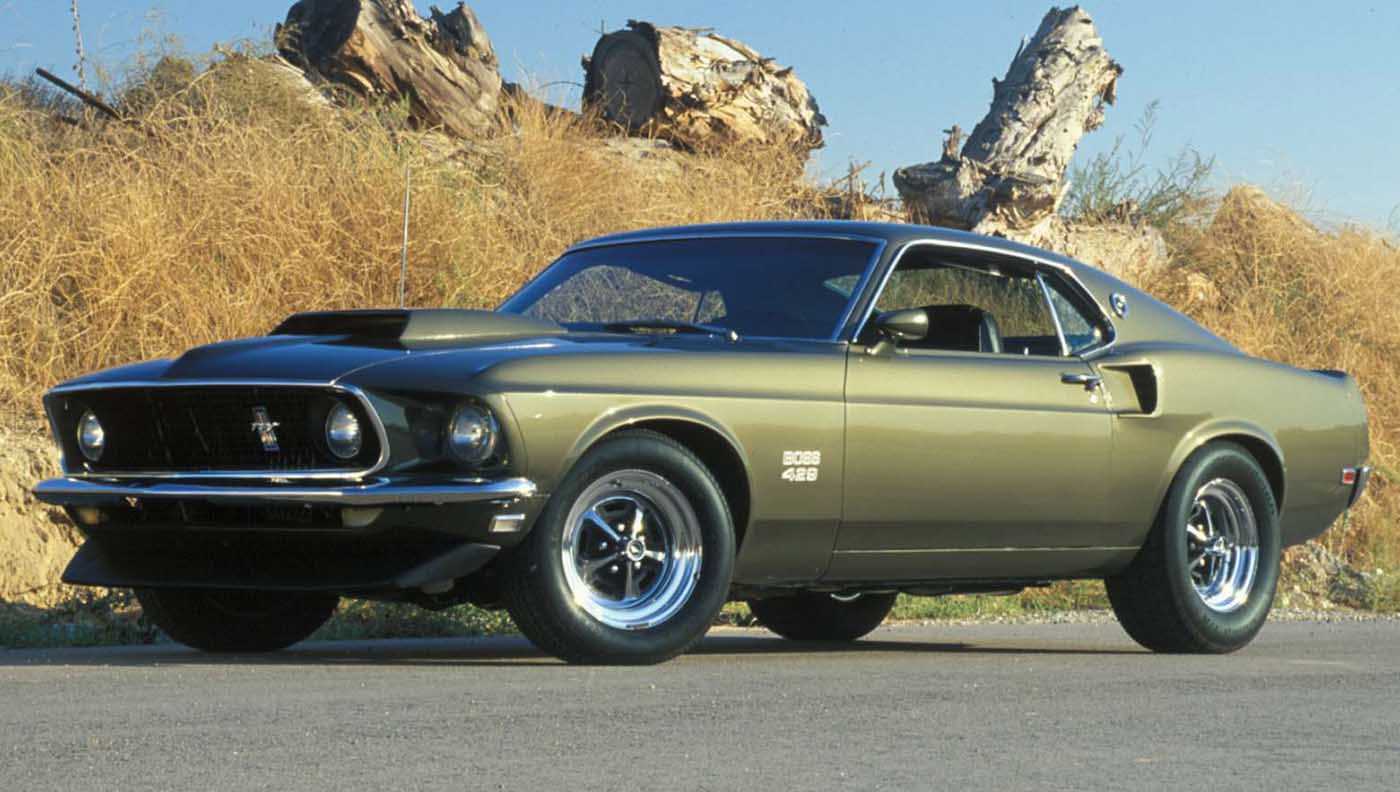
Also, The Boss 429 Mustang is a high-performance Ford Mustang variant that was offered by Ford in 1969 and 1970.
The Boss 429 is recognized as being among some of the rarest and highly valued muscle cars to date. In total there were 1359 original Boss 429s made. The origin of the Boss 429 was to fulfil Ford’s need to homologate the 429 semi-hemispherical engine for NASCAR racing. Ford was seeking to develop an engine that would better compete with the 426 Hemi from Chrysler in NASCAR’s Grand National Division, now known as the NASCAR Cup Series. NASCAR’s homologation rules required that at least 500 cars be fitted with this motor and sold to the general public. After much consideration, it was decided by Ford that the Mustang would be the car that would house this new engine.
With the release and homologation of the Dodge Charger Daytona from its rival manufacturer Dodge, the Boss 429 is solely left as a road-going version and all of its NASCAR plans were scrapped.
The Boss 429 engine evolved from the Ford 385 engine. It used four-bolt main caps, a forged steel crank and forged steel connecting rods. The engine featured aluminium cylinder heads, with a semi-hemispherical type combustion chamber which Ford called the “crescent”. These heads used the “dry-deck” method, meaning the coolant circuit for the block was separate from the cooling circuit for the head The “dry-deck” method of design is intended to strengthen the block by removing the open coolant jackets around the cylinder and reduce hot spots by providing more direct cooling. Each cylinder, oil passage and water passage had an individual “O” ring style seal to seal it tight. Although a head gasket is used, it only seals the cylinder for combustion so a failure at one point won’t compromise the others.
The Boss 429 engine came standard with a single Holley 4-barrel carburetor rated at 735 CFM mounted on an aluminium intake manifold that flowed well for its time. 1969 cars featured a hydraulic lifter camshaft while 1970 models got a solid lifter camshaft along with an improved dual exhaust system, though rated power output stayed the same.
The Mustang’s engine compartment was not wide enough to accommodate the massive Boss 429 engine, so Ford contracted with Kar Kraft of Dearborn, Michigan, to modify 4-speed Cobra Jet Mustangs to accept it. Kar Kraft was a Ford exclusive experimental facility that functioned as Vehicle Engineering for Ford’s Special Vehicles. Kar Kraft had previously developed the first GT40 MKII (winner of the 1966 24 Hours of Le Mans) and designed and built the GT40 MKIV (winner of the 1967 24 Hours of Le Mans).
Production of the Boss 429 began in 1968 at the Ford Rouge plant, where front apron assemblies revised to accept the large Boss 429 engine were installed during vehicle construction. These also provided a stronger and cleaner front structure, important considerations on such a performance car, and were coupled with reworked front fenders. The cars were then shipped to Kar Kraft’s new assembly plant in Brighton, Michigan for engine installation and further modifications.
Such a large big block engine made the car nose heavy. To help offset this, the battery was relocated to the trunk, and a 3/4″ sway bar was added to the rear end to limit body roll. This was the first Mustang ever fitted with a rear sway bar, giving it better handling than the other large engine Mustangs of the time, making it a much more capable track car. So did an oil cooler which allowed both high RPM and endurance loads on the engine, and a manually controlled hood scoop for bringing in denser air for more thorough combustion. For better ground clearance the front spoiler was made shallower than the Boss 302’s, and a 3.91 ratio rear axle came with a “Traction-Lock” limited slip differential. Other features included, color keyed dual racing mirrors, an 8,000rpm tachometer, and AM only radio.
Horsepower
The cars were advertised at 375 bhp (380 PS; 280 kW) at 5200 rpm and 450 lb⋅ft (610 N⋅m) of torque at 3400 rpm. Period dynamometer testing supports Ford’s rating. The speed equipment manufacturer Crane Cams tested engines that were stock as manufactured, with the exception of substituting tubular headers for the stock cast iron exhaust manifolds. For the 1969 hydraulic cam engine, they measured a peak of 352.0 bhp (262.5 kW) at 5500 rpm. The 1970 mechanical cam engine measured better, with a peak of 366.5 bhp (273.3 kW), also at 5500 rpm.
Both model years featured a toned-down exterior compared to other performance Mustangs of the era (see Boss 351, Boss 302, Mach 1), in that the only external identification of the car were the Boss 429 decals on the front fenders and unique enlarged hood scoop. The rest of the car featured a very clean look that was atypical of most performance Mustangs that Ford had produced, which often emphasized appearance over its reality. Both the spoiler and window louvers commonly seen on 1969–1970 Mach 1’s and Boss 302’s were missing.
Instead, to show just how special these cars were, they were given special NASCAR identification that was placed on the driver’s side door. Each car was given a “KK” number which stood for Kar Kraft. KK #1201 was the first Boss 429 and KK #2558 was the last Boss 429 made.
However, sales started to drop off for the 1970 Boss 429 Mustangs and with higher production costs, gas costs, and other internal Ford problems, it was decided that 1970 would be the last year of the Boss 429.
Today, these cars are highly sought after. As of 2008, auctions on eBay and at Barrett-Jackson have brought bids of over $375,000. In 2013 a black 1969 Ford Mustang Boss 429 Fastback (unrestored) sold for $417,000 at Mecum Auctions in Kissimmee, Florida. In 2016 a restored black 1969 Boss 429 sold for $500,000 at a Barrett-Jackson auction in Palm Beach, Florida.
1969 Model
A total of 859 Boss 429s were made by Ford in 1969, including two Cougars for the Lincoln/Mercury Race Division. All had black interiors, and came in one of five colors: Raven Black, Wimbledon White, Royal Maroon, Candy apple Red, and Black Jade). The fully functional hood scoop was the same color as the car, and noticeably larger than anything else offered on any Ford product but the two Boss 429 Cougars. This scoop would carry over to the 1970 model year but would be painted black on all cars. To this day, it is the largest factory hood scoop ever installed on a production Mustang.
All cars came with 4-speed manual transmissions. The huge engine shoehorned into even a modified Mustang front end left no room for air conditioning. Some early cars were known as “S” code cars and as such had a slightly different engine, with magnesium valve covers, NASCAR style forged internals, and close to no smog or emissions equipment. They are said to be more powerful than the later “T” and “A” code engines (which had the emissions related equipment to satisfy government regulations). The engines in some cases were removed from the cars for use in other applications such as tractor pulling, due to the extreme torque and horsepower the engine was capable of producing.
1970 Model
Ford made 499 Boss 429s in 1970. Five new exterior colors were available: Grabber Orange, Grabber Green, Grabber Blue, Calypso Coral, and Pastel Blue; and the interior was available in black or white and black. The hood scoops were all painted matte black. A Hurst shifter was standard equipment. A dealer-installed option of a six-pack intake and three 2-barrel carburetors was made available, though very few of these were sold.
Classic Recreations produces the 1969-70 Ford licensed Boss 429 as of April 2018.
Source: wikipedia (GNU Free Documentation License)
Photos via: Ford.com and performance.ford.com
